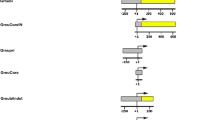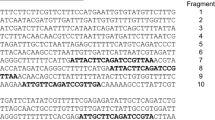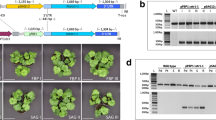Abstract
Introns are important sequence elements that modulate the expression of genes. Using the GUS reporter gene driven by the promoter of the rice (Oryza sativa L.) polyubiquitin rubi3 gene, we investigated the effects of the 5′ UTR intron of the rubi3 gene and the 5′ terminal 27 bp of the rubi3 coding sequence on gene expression in stably transformed rice plants. While the intron enhanced GUS gene expression, the 27-bp fused to the GUS coding sequence further augmented GUS expression level, with both varying among different tissues. The intron elevated GUS gene expression mainly at mRNA accumulation level, but also stimulated enhancement at translational level. The enhancement on mRNA accumulation, as determined by realtime quantitative RT-PCR, varied remarkably with tissue type. The augmentation by the intron at translational level also differed by tissue type, but to a lesser extent. On the other hand, the 27-bp fusion further boosted GUS protein yield without affecting mRNA accumulation level, indicating stimulation at translation level, which was also affected by tissue type. The research revealed substantial variation in the magnitudes of intron-mediated enhancement of gene expression (IME) among tissues in rice plants and the importance of using transgenic plants for IME studies.






Similar content being viewed by others
References
An G, Ebert PR, Miltra A, Ha SB (1988) Binary vectors. In: Galvin SB, Schilperoort RA (eds) Plant molecular biology manual. Kluwer Academic, Dordrecht, pp 1–19
Azhakanandam K, Mccabe MS, Power JB, Lowe KC, Cocking EC, Davey MR (2000) T-DNA transfer, integration, expression and inheritance in rice: effects of plant genotype and Agrobacterium super-virulence. J Plant Physiol 157:429–439
Bourdon V, Harvey A, Lonsdale DM (2001) Introns and their positions affect the translational activity of mRNA in plant cells. EMBO Rep 2:394–398
Bourdon V, Wickham A, Lonsdale D, Harwood W (2004) Additional introns inserted within the luciferase reporter gene stabilise transgene expression in wheat. Plant Sci 167:1143–1149
Butaye KMJ, Cammue BPA, Delaure SL, De Bolle MFC (2005) Approaches to minimize variation of transgene expression in plants. Mol Breed 16:79–91
Callis J, Fromm M, Walbot V (1987) Introns increase gene-expression in cultured maize cells. Genes Dev 1:1183–1200
Chaubet-Gigot N, Kapros T, Flenet M, Kahn K, Gigot C, Waterborg JH (2001) Tissue-dependent enhancement of transgene expression by introns of replacement histone H3 genes of Arabidopsis. Plant Mol Biol 45:17–30
Clancy M, Hannah LC (2002) Splicing of the maize Sh1 first intron is essential for enhancement of gene expression, and a T-rich motif increases expression without affecting splicing. Plant Physiol 130:918–929
Dean C, Jones J, Favreau M, Dunsmuir P, Bedbrook J (1988) Influence of flanking sequences on variability in expression levels of an introduced gene in transgenic tobacco plants. Nucleic Acids Res 16:9267–9283
Dong SJ, Qu R (2005) High efficiency transformation of tall fescue with Agrobacterium tumefaciens. Plant Sci 168:1453–1458
Dugdale B, Becker DK, Harding RM, Dale JL (2001) Intron-mediated enhancement of the banana bunchy top virus DNA-6 promoter in banana (Musa spp.) embryogenic cells and plants. Plant Cell Rep 20:220–226
Fu HY, Kim SY, Park WD (1995a) A potato Sus3 sucrose synthase gene contains a context-dependent 3′ element and a leader intron with both positive and negative tissue-specific effects. Plant Cell 7:1395–1403
Fu HY, Kim SY, Park WD (1995b) High-level tuber expression and sucrose inducibility of a potato Sus4 sucrose synthase gene require 5′-flanking and 3′-flanking sequences and the leader intron. Plant Cell 7:1387–1394
Gallagher SR (1992) Quantification of GUS activity by fluorometry. In: Gallagher SR (ed) GUS protocols: using the GUS gene as a reporter of gene expression. Academic Press, New York, pp 47–59
Gallie DR, Young TE (1994) The regulation of gene-expression in transformed maize aleurone and endosperm protoplasts—analysis of promoter activity, intron enhancement, and messenger-RNA untranslated regions on expression. Plant Physiol 106:929–939
Genschik P, Marbach J, Uze M, Feuerman M, Plesse B, Fleck J (1994) Structure and promoter activity of a stress and developmentally regulated polyubiquitin-encoding gene of Nicotiana tabacum. Gene 148:195–202
Hansen G, Chilton MD (1999) Lessons in gene transfer to plants by a gifted microbe. Curr Top Microbiol Immunol 240:21–57
Hobbs SLA, Warkentin TD, Delong CMO (1993) Transgene copy number can be positively or negatively associated with transgene expression. Plant Mol Biol 21:17–26
Hood EE, Gelvin SB, Melchers LS, Hoekema A (1993) New Agrobacterium helper plasmids for gene-transfer to plants. Transgenic Res 2:208–218
Ingham DJ, Beer S, Money S, Hansen G (2001) Quantitative real-time PCR assay for determining transgene copy number in transformed plants. Biotechniques 31:132–140
Jefferson RA, Kavanagh TA, Bevan MW (1987) Gus fusions: beta-glucuronidase as a sensitive and versatile gene fusion marker in higher-plants. EMBO J 6:3901–3907
Jeon JS, Lee S, Jung KH, Jun SH, Kim C, An G (2000) Tissue-preferential expression of a rice alpha-tubulin gene, OsTubA1, mediated by the first intron. Plant Physiol 123:1005–1014
Jin SG, Komari T, Gordon MP, Nester EW (1987) Genes responsible for the supervirulence phenotype of Agrobacterium tumefaciens A281. J Bacteriol 169:4417–4425
Jorgensen RA, Cluster PD, English J, Que QD, Napoli CA (1996) Chalcone synthase cosuppression phenotypes in petunia flowers: comparison of sense vs antisense constructs and single-copy vs complex T-DNA sequences. Plant Mol Biol 31:957–973
Joshi CP, Zhou H, Huang XQ, Chiang VL (1997) Context sequences of translation initiation codon in plants. Plant Mol Biol 35:993–1001
Kozak M (1999) Initiation of translation in prokaryotes and eukaryotes. Gene 234:187–208
Kozak M (2002) Pushing the limits of the scanning mechanism for initiation of translation. Gene 299:1–34
Koziel MG, Carozzi NB, Desai N (1996) Optimizing expression of transgenes with an emphasis on post-transcriptional events. Plant Mol Biol 32:393–405
Mascarenhas D, Mettler IJ, Pierce DA, Lowe HW (1990) Intron-mediated enhancement of heterologous gene-expression in maize. Plant Mol Biol 15:913–920
McElroy D, Zhang WG, Cao J, Wu R (1990) Isolation of an efficient actin promoter for use in rice transformation. Plant Cell 2:163–171
Morello L, Bardini M, Cricri M, Sala F, Breviario D (2006) Functional analysis of DNA sequences controlling the expression of the rice OsCDPK2 gene. Planta 223:479–491
Norris SR, Meyer SE, Callis J (1993) The intron of Arabidopsis thaliana polyubiquitin genes is conserved in location and is a quantitative determinant of chimeric gene-expression. Plant Mol Biol 21:895–906
Peach C, Velten J (1991) Transgene expression variability (position effect) of CAT and GUS reporter genes driven by linked divergent T-DNA promoters. Plant Mol Biol 17:49–60
Rethmeier N, Seurinck J, VanMontagu M, Cornelissen M (1997) Intron-mediated enhancement of transgene expression in maize is a nuclear, gene-dependent process. Plant J 12:895–899
Rollfinke IK, Silber MV, Pfitzner UM (1998) Characterization and expression of a heptaubiquitin gene from tomato. Gene 211:267–276
Rose AB (2002) Requirements for intron-mediated enhancement of gene expression in Arabidopsis. RNA 8:1444–1453
Rose AB (2004) The effect of intron location on intron-mediated enhancement of gene expression in Arabidopsis. Plant J 40:744–751
Rose AB, Last RL (1997) Introns act post-transcriptionally to increase expression of the Arabidopsis thaliana tryptophan pathway gene PAT1. Plant J 11:455–464
Samadder P, Sivamani E, Lu J, Li X, Qu R (2008) Transcriptional and post-transcriptional enhancement of gene expression by the 5′ UTR intron of rice rubi3 gene in transgenic rice cells. Mol Genet Genomics (in press). doi:10.1007/s00438-008-0323-8
Sawant SV, Singh PK, Gupta SK, Madnala R, Tuli R (1999) Conserved nucleotide sequences in highly expressed genes in plants. J Genet 78:123–131
Simpson GG, Filipowicz W (1996) Splicing of precursors to mRNA in higher plants: mechanism, regulation and sub-nuclear organisation of the spliceosomal machinery. Plant Mol Biol 32:1–41
Sivamani E, Qu R (2006) Expression enhancement of a rice polyubiquitin gene promoter. Plant Mol Biol 60:225–239
Sivamani E, Bahieldin A, Wraith JM, Al-Niemi T, Dyer WE, Ho THD, Qu R (2000) Improved biomass productivity and water use efficiency under water deficit conditions in transgenic wheat constitutively expressing the barley HVA1 gene. Plant Sci 155:1–9
Thomas JF, Downs RJ, Saravitz CH (2006) Pytotron procedural manual. North Carolina State University, Raleigh, pp 14–16
Wang MB, Waterhouse PM (2000) High-efficiency silencing of a beta-glucuronidase gene in rice is correlated with repetitive transgene structure but is independent of DNA methylation. Plant Mol Biol 43:67–82
Wang HY, Lee MM, Schiefelbein JW (2002) Regulation of the cell expansion gene RHD3 during Arabidopsis development. Plant Physiol 129:638–649
Zhang WG, McElroy D, Wu R (1991) Analysis of rice Act1 5′ region activity in transgenic rice plants. Plant Cell 3:1155–1165
Acknowledgments
The authors thank the Plant Analysis Group at Syngenta Biotechnology, Inc., for determining the transgene copy number using realtime PCR, Dr. S. Spiker and M. Massel for assistance on using the fluorometer and phosphor imager, Dr. R. Shi for assistance on using the ABI 7900 HT Fluorescent Detection System, as well as Drs. J. Thomas, J. Shurtleff, and C. Saravitz, and J. Edwards for assistance on using the North Carolina State University Phytotron for plant growth. Authors are grateful to Drs. G. Allen, N. Allen, R. Dewey, and J. Nicholson for helpful discussions on the project. This work was supported, in part, by grants from the Center for Turfgrass Environmental Research and Education, North Carolina State University, The Consortium for Plant Biotechnology Research, Inc., and Syngenta Biotechnology, Inc.
Author information
Authors and Affiliations
Corresponding author
Additional information
Communicated by J. Zhu.
Rights and permissions
About this article
Cite this article
Lu, J., Sivamani, E., Azhakanandam, K. et al. Gene expression enhancement mediated by the 5′ UTR intron of the rice rubi3 gene varied remarkably among tissues in transgenic rice plants. Mol Genet Genomics 279, 563–572 (2008). https://doi.org/10.1007/s00438-008-0333-6
Received:
Accepted:
Published:
Issue Date:
DOI: https://doi.org/10.1007/s00438-008-0333-6




